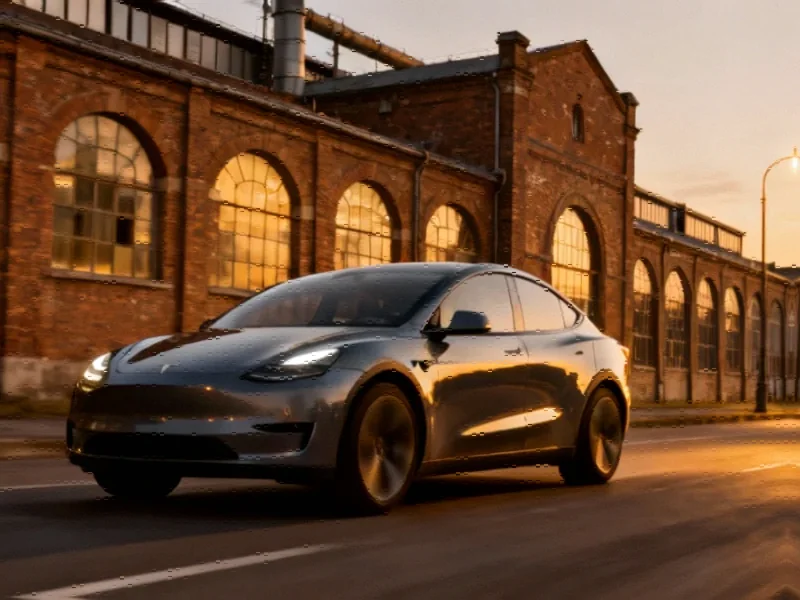Surface Calm Masks Underlying Struggle
While Europe’s automotive industry appears to be stabilizing after years of pandemic-related disruptions and supply chain challenges, beneath the serene surface lies an industry fighting for its future. Recent sales stabilization and optimistic profit margin projections for 2026 conceal a deeper battle against increasingly formidable Chinese competitors who are leveraging significant price advantages and manufacturing prowess.
Regulatory Pressures Create Unintended Consequences
The European Union’s stringent emissions regulations, which mandate a complete transition to electric vehicles by 2035, have inadvertently created an opening for Chinese manufacturers. With a documented 30% price advantage in EV production, Chinese automakers stand ready to fill market gaps that European companies struggle to address profitably. Industry leaders and manufacturing nations are now lobbying Brussels to reconsider what they term an “EV monopoly” and embrace technology-neutral approaches to emissions reduction.
Despite temporary relief from recent EU tariffs on Chinese EVs, the reprieve appears short-lived. Chinese manufacturers are rapidly establishing production facilities within Europe itself, circumventing trade barriers while maintaining their competitive edge. This strategic shift threatens to render numerous European factories obsolete, potentially devastating an industry that employs millions and represents one of Europe’s most prestigious economic sectors.
Production Cuts Signal Deeper Issues
The scale of the challenge becomes evident through recent production adjustments across the continent. Industry giants Volkswagen and Stellantis, which collectively account for approximately half of Europe’s new sedan and SUV market, have implemented significant factory shutdowns and temporary production halts. Six Stellantis plants across Europe have seen temporary closures, while Volkswagen has scaled back operations on a similar scale, with its electric vehicle production lines particularly affected.
These developments occur despite optimistic assessments from some quarters. GlobalData’s monthly Western Europe outlook report suggests that improved trade relations and economic conditions have brightened the regional picture. “When combined with rising real wages and increased government spending particularly in Germany, the outlook for the region has improved since mid-year,” the report noted, while acknowledging that sales remain substantially below pre-pandemic levels.
European Counteroffensive Gains Traction
European manufacturers have not been idle in facing these challenges. According to analysis from Berenberg Bank, the recent Munich Motor Show demonstrated that European automakers are finally closing the competitive gap. “The September Munich Motor Show finally showcased European products now approaching or on par with Chinese competitors in terms of specifications—and at significantly improved cost levels,” the bank reported, pointing specifically to BMW’s iX3 “Neue Klasse” as potentially achieving margin parity with internal combustion vehicles by 2026.
Industry expert Matt Schmidt of Schmidt Automotive Research confirms this assessment, noting that European manufacturers have made substantial progress in production efficiency. “Previously Europeans had to make cost cuts to get EVs as close to positive profit margins as possible. Now, as battery prices come down and they adopt to using cheaper LFP technology, they are achieving the best of both worlds of profits and being able to return some of that windfall into higher quality interiors,” Schmidt explained.
Chinese Advance Continues Unabated
Despite European improvements, the Chinese competitive threat continues to intensify. Market penetration figures tell a concerning story, with Chinese brands capturing 13% of the UK market in September alone, a figure that analysts project could reach 30% within two years. Across Europe’s five largest markets, Chinese manufacturers achieved a record 7.3% market share in September, driven by strong performances from models like the MG HS, BYD Seal U, and Jaecoo 7 plug-in hybrid.
The driving force behind this export push stems from brutal domestic competition within China itself. Industry observer Michael Dunne notes in his latest analysis that “extreme overcapacity has ignited brutal price wars at home, causing profits to vanish. This is forcing Chinese automakers to face an ultimatum: export or die.”
Structural Vulnerabilities Exposed
The challenge extends beyond vehicle manufacturing to encompass the entire automotive supply chain. Chinese dominance in critical components—from rare earth magnets essential for electric motors to battery materials—creates additional vulnerability for European manufacturers. Without reliable access to these materials, European production facilities would face immediate disruption.
Consultancy AlixPartners projects that as many as eight European factories could become surplus to requirements by 2030 due to subdued demand and Chinese competition. Current factory utilization rates averaging just 55% of capacity underscore the severity of the situation. Investment researcher Jefferies anticipates Chinese brands could account for up to 6% of European production by 2028, including output from BYD plants being established in Hungary, Turkey, and potentially Spain.
Strategic Dilemmas Loom Large
European policymakers face difficult choices in responding to these challenges. While protective measures might safeguard domestic manufacturing, they risk triggering retaliation that could devastate European automakers’ remaining profitable operations in China. As Dunne notes, “The pain for Western automakers is real. As a group, they are selling eight million fewer vehicles in China than they did five years ago.”
The industry’s future may hinge on developing new supply chain architectures that reduce dependency on any single source. As companies navigate these complex market trends, the integration of advanced technology systems becomes increasingly critical for maintaining competitive parity.
What remains clear is that the European automotive sector stands at a critical juncture. The coming years will determine whether this cornerstone of European industry can adapt to new competitive realities or faces progressive displacement by manufacturers who have mastered the economics of electric vehicle production at scale. For ongoing coverage of European automotive sector developments, follow our continued reporting on this evolving story.
This article aggregates information from publicly available sources. All trademarks and copyrights belong to their respective owners.
Note: Featured image is for illustrative purposes only and does not represent any specific product, service, or entity mentioned in this article.
